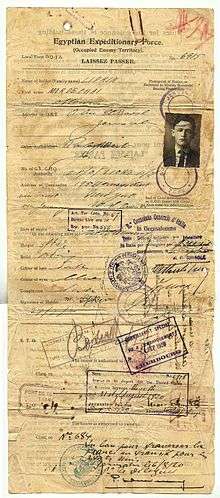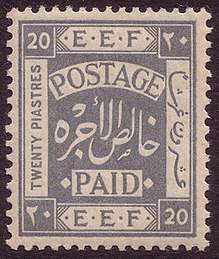Egyptian Expeditionary Force
The Egyptian Expeditionary Force (EEF) was a British Empire military formation, formed on 10 March 1916 under the command of General Archibald Murray from the Mediterranean Expeditionary Force and the Force in Egypt (1914–15), at the beginning of the Sinai and Palestine Campaign of the First World War.

| Egyptian Expeditionary Force | |
|---|---|
| Active | 1916–19 |
| Country | |
| Engagements | First World War
|
| Commanders | |
| Notable commanders | Archibald Murray (1916–17) Edmund Allenby (1917–19) |

History
Formed in the British protectorate of the Sultanate of Egypt, the initially small force was raised to guard the Suez Canal and Egypt. After the withdrawal from the Gallipoli Campaign the force grew into a large reserve force designed to provide reinforcements for the Western Front, while the Western Frontier Force fought in the Senussi Campaign from 1915 to 1917, and the Eastern Frontier Force defended the canal at the Battle of Romani in August 1916.[1][2][3][4] Following the victory at Romani, part of Eastern Force pursued the Ottoman Empire invading force back to Palestine after the victories at the Battle of Magdhaba in December 1916 and the Battle of Rafa in January 1917, by which time Desert Column had been formed within Eastern Force. These victories which resulted in the recapture of substantial Egyptian territory were followed in March and April, by two EEF defeats on Ottoman Turkish Empire territory, at the First and Second Battles of Gaza in southern Palestine.[5]
During the Stalemate in Southern Palestine from April to October 1917, Murray consolidated the EEF's position and in June General Edmund Allenby took command and began preparations to take the offensive, employing manoeuvre warfare He reorganised the force into the XX Corps, XXI Corps and Desert Mounted Corps formerly Desert Column.[6] On 31 October two corps captured Beersheba defended by the Turkish III Corps (which had fought at Gallipoli), which weakened their defences stretching almost continually from Gaza to Beersheba. Subsequently the Battle of Tel el Khuweilfe, the Third Battle of Gaza and the Battle of Hareira and Sheria forced the withdrawal from Gaza on the night of 6/7 November at the beginning of the pursuit to Jerusalem. During the subsequent operations, about fifty miles (80 km) of formerly Turkish territory, was captured as a result of the EEF victories at the Battle of Mughar Ridge, fought between 10 and 14 November, and the Battle of Jerusalem fought between 17 November and 30 December. Serious losses on the Western Front in March 1918 during the German Spring Offensive, forced the British Empire to send reinforcements from the EEF. During this time, two unsuccessful attacks were made to capture Amman and to capture Es Salt in March and April 1918, before Allenby's force resumed the offensive, again employing manoeuvre warfare at the Battle of Megiddo. The successful infantry battles at the Battle of Tulkarm and the Battle of Tabsor, created gaps in the Ottoman front line, enabling the pursuit by the Desert Mounted Corps to encircle the infantry fighting in the Judean Hills when fighting occurred during the Battle of Nazareth, the Afulah, Beisan, the Jenin, the Battle of Samakh, and the capture of Tiberias. In the process the EEF destroyed three Turkish Armies during the Battle of Sharon, the Battle of Nablus and the Third Transjordan attack, capturing thousands of prisoners and large quantities of equipment. Subsequently the EEF pursued the surviving German and Turkish forces to Damascus, and Aleppo, before the Ottoman Turkish Empire agreed to the Armistice of Mudros on 30 October 1918, ending the Sinai and Palestine Campaign. The British Mandate of Palestine, and the French Mandate for Syria and Lebanon were created to administer the captured territories.[7]
Structure
See also
- Sinai and Palestine Campaign
- History of Palestine
- Postage stamps and postal history of Palestine
References
- Bruce 2002, p. 34
- Keogh 1955, p. 32
- Wavell 1968, p. 41
- Falls 1930 Vol. 1 pp. 69–204
- Falls 1930 Vol. 1 pp. 242–350
- Falls 1930 Vol. 1 pp. 351–372, Vol. 2 pp. 1–43
- Falls 1930 Vol. 2 pp. 44–647
Bibliography
- "General Staff General Headquarters Egyptian Expeditionary Force". Canberra: Australian War Memorial. February 1918.
- "General Staff Headquarters Anzac Mounted Division War Diary". Canberra: Australian War Memorial. December 1916. Archived from the original on 2011-03-21.
- "1st Light Horse Brigade War Diary". Canberra: Australian War Memorial. March 1917. Archived from the original on 2011-03-21.
- Bowman–Manifold, M. G. E. (1923). An Outline of the Egyptian and Palestine Campaigns, 1914 to 1918 (2nd ed.). Chatham: W. & J. Mackay for The Institution of Royal Engineers. OCLC 224893679.
- Bruce, Anthony (2002). The Last Crusade: The Palestine Campaign in the First World War. London: John Murray. ISBN 978-0-7195-5432-2.
- Carver, Michael, Field Marshal Lord (2003). The National Army Museum Book of The Turkish Front 1914–1918 The Campaigns at Gallipoli, in Mesopotamia and in Palestine. London: Pan Macmillan. ISBN 978-0-283-07347-2.
- Coulthard-Clark, Chris (1998). Where Australians Fought: The Encyclopaedia of Australia's Battles. St Leonards: Allen and Unwin. ISBN 1-86448-611-2.
- Cutlack, Frederic Morley (1941). The Australian Flying Corps in the Western and Eastern Theatres of War, 1914–1918. Official History of Australia in the War of 1914–1918. VIII (11th ed.). Canberra, ACT: Australian War Memorial. OCLC 220900299.
- Falls, Cyril; Becke, A. F. (maps) (1930). Military Operations Egypt & Palestine from June 1917 to the End of the War. Official History of the Great War Based on Official Documents by Direction of the Historical Section of the Committee of Imperial Defence. II. Part I. London: HMSO. OCLC 644354483.
- Falls, Cyril; Becke, A. F. (maps) (1930). Military Operations Egypt & Palestine from June 1917 to the End of the War. Official History of the Great War Based on Official Documents by Direction of the Historical Section of the Committee of Imperial Defence. II. Part II. London: HMSO. OCLC 256950972.
- Gullett, Henry S. (1941). The Australian Imperial Force in Sinai and Palestine, 1914–1918. Official History of Australia in the War of 1914–1918. VII (11th ed.). Canberra: Australian War Memorial. OCLC 220900153.
- Jones, Ian (1987). Australians at War: The Australian Light Horse. North Sydney: Time-Life Books (Australia). OCLC 255503233.
- Keogh, E. G.; Graham, J. (1955). Suez to Aleppo. Melbourne: Directorate of Military Training by Wilkie. OCLC 220029983.
- McGuirk, Russell (2007). The Sanusi's Little War: The Amazing Story of a Forgotten Conflict in the Western Desert, 1915–1917. London: Arabian Publishing. OCLC 156803398.
- Massey, William T. (1920). Allenby's Final Triumph. London: Constable. OCLC 345306.
- Powles, C. Guy; Wilkie, A. (1922). The New Zealanders in Sinai and Palestine. Official History New Zealand's Effort in the Great War. III. Auckland: Whitcombe & Tombs. OCLC 2959465.
- Preston, R. M. P. (1921). The Desert Mounted Corps: An Account of the Cavalry Operations in Palestine and Syria 1917–1918. London: Constable. OCLC 3900439.
- Wavell, Field Marshal Earl (1968) [1933]. "The Palestine Campaigns". In Sheppard, Eric William (ed.). A Short History of the British Army (4th ed.). London: Constable. OCLC 35621223.
- Woodward, David R. (2006). Hell in the Holy Land: World War I in the Middle East. Lexington: The University Press of Kentucky. ISBN 978-0-8131-2383-7.